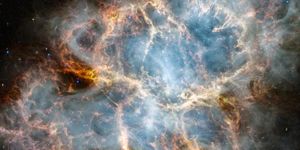November 2023 Celestial Events
Labroots believes in the sharing of knowledge, and we wish to highlight key celestial events for November 2023 that all skywatchers are sure to enjoy. The night sky is full of wonders, from our Moon to planets to objects both within and well beyond the reaches of our solar system, and the events listed below are sure to get you excited for the wonders of astronomy. Each event is labeled in all caps for the type of event (e.g., MOON, PLANET, COMET, etc.) to provide skywatchers additional excitement to catch these incredible events!
November 3 (PLANET): Jupiter will be in opposition. This means the Sun, Earth and Jupiter will be lined up with Jupiter being the farthest of the objects. An object’s opposition means this is the most beneficial time to observe it, as it will be closest to Earth, along while being fully lit by the Sun, meaning it will be in its full phase.
November 4 (PLANET): Saturn ends retrograde motion. This means Saturn’s path across the sky will stop going in reverse and start moving forward again. Retrograde motion is experienced for all planets since they all orbit at different speeds, so they appear to move backwards during specific times of our year. For example, Saturn began appearing to move backwards in the sky on June 17 and will end this period on November 4 of this year.
November 5 (MOON): Last Quarter Moon. When observing from the Earth, this is when the entire left side of the Moon is lit while the right side is encased in darkness.
November 6 (METEOR SHOWER): Peak of Southern Taurids meteor shower. This means the Southern Taurids meteor shower will be at its maximum and viewers are recommended to see them just after midnight with an estimated five meteors per hour and some are anticipated to be fireballs.
November 9 (MOON and PLANET): The Earth’s Moon and the planet Venus will pass within 1-degree of each other.
November 10 (COMET): The comet C/2023 H2 (Lemmon) will make its closest approach to Earth, also known as perigee, at 0.19 astronomical units (AU), or approximately 17,662,000 miles away. For context, the orbit of Mars is approximately 50 million miles from the Earth’s orbit, so Lemmon will be between Earth and Mars during its perigee.
November 11 (MOON and STAR): The Earth’s Moon and the star Spica will pass within just over 2-degrees of each other.
November 13 (MOON): New Moon. When observing from the Earth, this is when the entire Moon will be completely encased in darkness.
November 14 (MOON, PLANET, and STAR): The Earth’s Moon will pass just over 1-degree from the planet Mercury and just under 1-degree from the star Antares.
November 16 (PLANET and STAR): The planet Mercury will pass just over 2-degrees from the star Antares.
November 18 (METEOR SHOWER, PLANET, and SUN): Peak of Leonids meteor shower. This means the Leonids meteor shower will be at its maximum and viewers are recommended to see them just after midnight with an estimated 10-15 meteors per hour and some are anticipated to be fireballs. Additionally, Mars will be in conjunction with the Sun, meaning the Red Planet will be on the opposite side of the Sun from Earth. This is clearly unobservable, but just a neat way to know where Mars will be located during this time.
November 20 (MOON and PLANET): First Quarter Moon. When observing from the Earth, this is when the entire right side of the Moon is lit while the left side is encased in darkness. Additionally, the Moon will pass within just over 2-degrees from the planet Saturn.
November 21 (METEOR SHOWER): Peak of Alpha Monocerotids meteor shower. This means the Alpha Monocerotids meteor shower will be at its maximum and viewers are recommended to see them just after midnight with variable number of meteors per hour and some are anticipated to be fireballs.
November 25 (MOON and PLANET): The Earth’s Moon will pass just over 2-degrees from the planet Jupiter.
November 27 (MOON and CONSTELLATION): Full Beaver Moon, which was given this name from Native American tribes in celebration of beavers. Additionally, the Moon will pass just over 1-degree from the constellation Pleiades.
November 28 (METEOR SHOWER, PLANET, and STAR): Peak of November Orionids meteor shower. This means the November Orionids meteor shower will be at its maximum and viewers are recommended to see them just after midnight with three meteors per hour and some are anticipated to be fireballs. Additionally, the planet Venus will pass just over 3-degrees from the star Spica.
Stay tuned for December 2023 celestial events!
As always, keep doing science & keep looking up!
Sources: Star Walk 2, EarthSky, Earth.com, EarthSky (1), In-The-Sky.org, NASA, ThePlanets.org, Almanac.com, NewScientist








